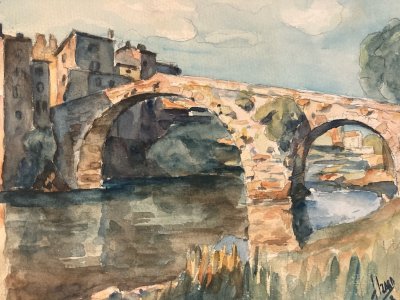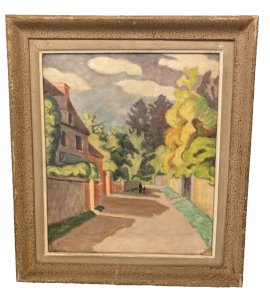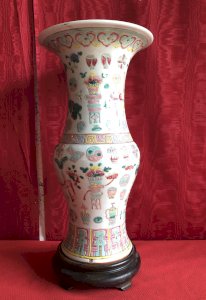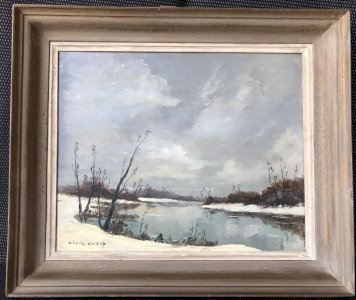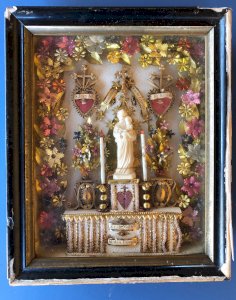- Sell Now
- Home
-
FURNISH
All STORAGE FURNITURE • Wardrobe • Chests of drawers, Chiffonnier • Sideboard • Shelves, Bookshelves • File cabinet • Sewing Furniture • Bar cabinet • TV Stand • Trunk, Chest TABLE & BEDSIDE TABLE • Dinner Table • Coffee table, side table, end table & Bedside • Console, Pedestal table & Selette • Serving Table, Trolley • Card Table • Draper's counter & table SEAT • Sofa • Armchair • Chair • Stool • Bench • Daybed • Beanbag & Footrest • Deckchair & Outdoor DESK, SECRETARY, DRESSING TABLE GARDEN LOUNGE BEDDING • Bed • Bedhead • Cradle, Moses basket CRAFT FURNITURE, WORKSHOP • Workbench • Stool, Ladder, Step • Easel & Trestle SCREEN PIANO
-
DECORATE
All TO PUT • Sculpture, Statuette • Vase & Planter • Dame Jeanne, Bonbonne & Flacon • Bridal globe, Dome • Pin tray, Ashtray • Candlestick & Candle • Photo frame • Stone, Fossil, Mineral • Earth Globe MIRROR WALL DECORATION • Painting • Engraving & Illustration • Poster • Tapestry • Wall Frame • Plate & Sign • Juju Hat & Wall Paniel • Mask • Hunting Trophy • Other object to hang CLOCK, PENDULUM & ALARM CLOCK ARRANGEMENT • Jar, Box & Case • Basket, Wastebasket & Crates • Magazine Rack & Vinyl Holder • Display & Spinner • Coat hook & Coat rack • Furniture Valet & Mannequin • Towel Holder • Suitcase & Travel Bag • Bottle Rack • Umbrella holder BATHROOM OFFICE • Mail holder • Bookends • Sulphide & Paperweight • Stationery FIREPLACE ACCESSORIES HOBBIES • Vintage Sport • Music • Vintage device • Smoking Item • Militaria, Ancient weapon • Miniature Vehicle • Game, Playing Cards • Collection object & Curiosity BIRD CAGE RELIGION, SPIRITUALITY
- TEXTURE
- ILLUMINATE
-
ACCOMODATE
All TABLE & SERVING • Plate • Silverware • Knife Holder • Glass • Bowl, Mug, Cup • Bowl, Ramekin & Cup • Dish, Cup & Salad Bowl • Tray, Basket & Server • Table Mat • Pitcher, Carafe, Bottle, Tea & Coffee Jug • Ice Bucket • Salt & Pepper shakers, Oil & Vinegar shakers • Sugar and jam maker • Gravy boat • Butter dish • Egg cup • Terrine OLD BALANCE CUTTING BOARD GRINDER CASSEROLE, SAUCEPAN & PAN KITCHEN UTENSIL & ACCESSORY
- TINKER
- KIDS
- Jewelry & Accessories
Login
Description
Watercolor of Pérouges by Henri-Alexis SCHAEFFER Dimensions with frame: 51 x 40cm Dimensions of the painting: 36 x 25.5 cm Biography Henri-Alexis Schaeffer was born on August 9, 1900 in Paris1, he is the son of Georges Casimir Schaeffer, employee and Marie Joséphine Caroline Alexia Vincent, seamstress2. At 19, he will live in Viroflay. He will study arts and will be one of the students of Fernand Cormon at the Ecole des Beaux-Arts in Paris. At the age of 20, he performs his compulsory military service and is incorporated as a soldier in the 19th Battalion of Hunters walk. He will take part in the Pays Rhénans3 campaign. On September 15, 1921 in Sèvres, Henri-Alexis Schaeffer married Olga Toussaint, also a young artist (poet, designer, painter, etc.). They will settle in Viroflay4. In 1932, he is one of the illustrator-caricaturist of the political newspaper L'Animateur des Temps Nouveaux and seems to begin a long series of illustrations at Casterman in 1933. He will also illustrate several newspapers of the Bonne editions Press until the war begins. In 1934, he became a member of the Society of French Artists which allowed him to exhibit many works each year at the Paris Salon. These watercolors and oils on canvas are inspired by these observations during these various trips: Paintings related to Paris and its region ("La Rue de la Montagne-Sainte-Geneviève" from 1951, "Fontainebleau - Le Château et l'Etang des Carpes" around 1940, "Rue de Bièvre", "La Concorde" in 1964, "The Card Game at La Bougnate" in 1950, "Le Petit Bistrot" in 1950...)Paintings of religious architecture ("The Saint-Basile d'Etampes Church" from 1948, "Evreux Cathedral", "Saint-Severin Church" from 1951, "Chartres Cathedral", "Messas Church", "Notre-Dame de Paris" in 1942, "La Chapelle de Nevez" in 1959, ...) Paintings of Breton landscapes ("Sardiniers in the bay of Douarnenez", "Sarzeau in Morbihan" in 1962, "Sailboats in the port", "Tunas in the Morning" ...)Paintings of Corsican landscapes ("Bastia from the pier of the Old Port", "View of Bonifacio", "Landscape of Corsica", "L'Ile Rousse" in 1951 ...)Portraits ("Portrait of Mme AD" in 1952 ...) During the 2nd World War, he is recalled to activity and joins his battalion of hunters. He will be taken prisoner in 1940 like more than two million French people. He was sent to Germany at Stalag IV A in Elsterhorst and then integrated into the administrative center of the Stalag in February 1941 in Hohnstein. There he met many French prisoners and took an active part in the collective animation: he joined the troupe of the Castel-Théâtre of Stalag IV-A as a decorator5 (curtains, painted wooden decorations, costumes, etc.) and thus participated in the first two tours of the Kommandos (1941). André Herisson replaced him in 1942. Henri Schaeffer also illustrated the programs of the tour which were sold to finance the Mutuelle du Stalag helping orphans or the families of prisoners in need. He will also decorate the central room of the Château d'Hohnstein, one of whose works represents a fresco of the city of Nice6. His activity will also allow him to illustrate the camp newspaper "Le Moineau" for which he will provide drawings for the headline of the newspaper as well as several portraits of the most important people of the administrative center of Hohnstein7. On November 27, 1941, he is repatriated8 as having participated in the 1st World War although he did not9. He will never forget his comrades in captivity and will keep in touch via the Stalag IV A Alumni Association with whom he has an almost monthly correspondence10. This is how he kept close contact with the former Confidant of Stalag IV-A, Abbé Huby, who officiated at Argenteuil and painted his Church there, but also with the Chevallier family, whose walls he decorated in their inn-restaurant on Ile Rousse in 195110. The series of paintings linked to Corsica began at this period: "(The Island of Beauty) did not steal its name, says SCHAEFFER. Corsica is much wilder and more grandiose than the Côte-d'Azur. Ile Rousse is a rocky outcrop on the western shore. Red mountain, green or blue sea: almost everywhere the gaze enjoys both at the same time. It is of an unimaginable brilliance. rocks) are dotted with eucalyptus, almond trees, fragrant rosemary. All this vegetation is within easy reach."11. This same year 1951, he will become Vice-President of the Prisoners' Association and each year will offer a canvas for the annual lottery of the Amicale in order to raise funds for widows in difficulty, orphans and the edition of the newspaper. . He seems to paint and exhibit works in the cellars of the Cabaret "Le Corsaire" in 1948. In 1952, his wife Olga Toussaint in turn joined the Salon des Artistes Français. This year they are exhibiting together. Henri Schaeffer won the Chantal de Chauvigny Prize there for his watercolors "L'Hôtel de Sens" and "La Rue de la Montagne Saint-Geneviève". He died on February 28, 19751 in Neuilly-sur-Seine.
Réf :
#42095
Related Products
Comments
Henri-Alexis SCHAEFFER 1900-1975: WATERCOLOR VILLAGE PEROUGES 1948
349€
Good
42420 Lorette
Ce site contient des liens d’affiliation pour lesquels je peux recevoir une compensation.
Description
Watercolor of Pérouges by Henri-Alexis SCHAEFFER Dimensions with frame: 51 x 40cm Dimensions of the painting: 36 x 25.5 cm Biography Henri-Alexis Schaeffer was born on August 9, 1900 in Paris1, he is the son of Georges Casimir Schaeffer, employee and Marie Joséphine Caroline Alexia Vincent, seamstress2. At 19, he will live in Viroflay. He will study arts and will be one of the students of Fernand Cormon at the Ecole des Beaux-Arts in Paris. At the age of 20, he performs his compulsory military service and is incorporated as a soldier in the 19th Battalion of Hunters walk. He will take part in the Pays Rhénans3 campaign. On September 15, 1921 in Sèvres, Henri-Alexis Schaeffer married Olga Toussaint, also a young artist (poet, designer, painter, etc.). They will settle in Viroflay4. In 1932, he is one of the illustrator-caricaturist of the political newspaper L'Animateur des Temps Nouveaux and seems to begin a long series of illustrations at Casterman in 1933. He will also illustrate several newspapers of the Bonne editions Press until the war begins. In 1934, he became a member of the Society of French Artists which allowed him to exhibit many works each year at the Paris Salon. These watercolors and oils on canvas are inspired by these observations during these various trips: Paintings related to Paris and its region ("La Rue de la Montagne-Sainte-Geneviève" from 1951, "Fontainebleau - Le Château et l'Etang des Carpes" around 1940, "Rue de Bièvre", "La Concorde" in 1964, "The Card Game at La Bougnate" in 1950, "Le Petit Bistrot" in 1950...)Paintings of religious architecture ("The Saint-Basile d'Etampes Church" from 1948, "Evreux Cathedral", "Saint-Severin Church" from 1951, "Chartres Cathedral", "Messas Church", "Notre-Dame de Paris" in 1942, "La Chapelle de Nevez" in 1959, ...) Paintings of Breton landscapes ("Sardiniers in the bay of Douarnenez", "Sarzeau in Morbihan" in 1962, "Sailboats in the port", "Tunas in the Morning" ...)Paintings of Corsican landscapes ("Bastia from the pier of the Old Port", "View of Bonifacio", "Landscape of Corsica", "L'Ile Rousse" in 1951 ...)Portraits ("Portrait of Mme AD" in 1952 ...) During the 2nd World War, he is recalled to activity and joins his battalion of hunters. He will be taken prisoner in 1940 like more than two million French people. He was sent to Germany at Stalag IV A in Elsterhorst and then integrated into the administrative center of the Stalag in February 1941 in Hohnstein. There he met many French prisoners and took an active part in the collective animation: he joined the troupe of the Castel-Théâtre of Stalag IV-A as a decorator5 (curtains, painted wooden decorations, costumes, etc.) and thus participated in the first two tours of the Kommandos (1941). André Herisson replaced him in 1942. Henri Schaeffer also illustrated the programs of the tour which were sold to finance the Mutuelle du Stalag helping orphans or the families of prisoners in need. He will also decorate the central room of the Château d'Hohnstein, one of whose works represents a fresco of the city of Nice6. His activity will also allow him to illustrate the camp newspaper "Le Moineau" for which he will provide drawings for the headline of the newspaper as well as several portraits of the most important people of the administrative center of Hohnstein7. On November 27, 1941, he is repatriated8 as having participated in the 1st World War although he did not9. He will never forget his comrades in captivity and will keep in touch via the Stalag IV A Alumni Association with whom he has an almost monthly correspondence10. This is how he kept close contact with the former Confidant of Stalag IV-A, Abbé Huby, who officiated at Argenteuil and painted his Church there, but also with the Chevallier family, whose walls he decorated in their inn-restaurant on Ile Rousse in 195110. The series of paintings linked to Corsica began at this period: "(The Island of Beauty) did not steal its name, says SCHAEFFER. Corsica is much wilder and more grandiose than the Côte-d'Azur. Ile Rousse is a rocky outcrop on the western shore. Red mountain, green or blue sea: almost everywhere the gaze enjoys both at the same time. It is of an unimaginable brilliance. rocks) are dotted with eucalyptus, almond trees, fragrant rosemary. All this vegetation is within easy reach."11. This same year 1951, he will become Vice-President of the Prisoners' Association and each year will offer a canvas for the annual lottery of the Amicale in order to raise funds for widows in difficulty, orphans and the edition of the newspaper. . He seems to paint and exhibit works in the cellars of the Cabaret "Le Corsaire" in 1948. In 1952, his wife Olga Toussaint in turn joined the Salon des Artistes Français. This year they are exhibiting together. Henri Schaeffer won the Chantal de Chauvigny Prize there for his watercolors "L'Hôtel de Sens" and "La Rue de la Montagne Saint-Geneviève". He died on February 28, 19751 in Neuilly-sur-Seine.
Réf :
#42095
 English
English  Français
Français 








